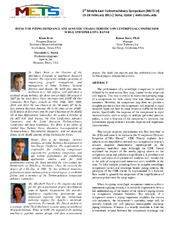| dc.description.abstract | The performance of a centrifugal compressor is usually defined by its head versus flow map, limited by the surge and stall regions. This map is critical to assess the operating range of a compressor for both steady state and transient system scenarios. However, the compressor map does not provide a complete picture on how the compressor will respond to rapid transient inputs and how its surge behavior is affected by these events. Specifically, the response of the compressor to rapid transient events, such as single or multiple (periodic) pressure pulses, is also a function of the compressor’s upstream and downstream piping system’s acoustic response and impedance characteristics.
This unique response phenomenon was first described in the 1970s and came to be known as the “Compressor Dynamic Response (CDR) Theory”. CDR Theory explains how pulsations are amplified or reduced by a compression system’s acoustic response characteristic superimposed on the compressor head-flow map. Although the CDR Theory explained the impact of the nearby piping system on the compressor surge and pulsation amplification, it provided only limited usefulness as a quantitative analysis tool, mainly due to the lack of computational numerical tools available at the time. To fully analyze pulsating flows in complex centrifugal compressor suction and discharge header piping systems, the principles of the CDR should be implemented in a dynamic flow model to quantify the magnitude of the amplifications of pressures pulses near the surge region.
When designing centrifugal compressor stations within a transmission piping system, it is critically important to have a full understanding of the impact of the station’s piping system on compressor dynamic behavior. For example, if a compressor system’s piping impedance amplifies the suction side pulsations, the compressor’s operating range will be severely limited and will produce unacceptable discharge piping vibrations. Whereas it is usually desirable to limit the downstream volume between the compressor discharge and
3rd Middle East Turbomachinery Symposium (METS III)
15-18 February 2015 | Doha, Qatar | mets.tamu.edu
Copyright © 2015 by Turbomachinery Laboratory, Texas A&M Engineering Experiment Station
the check valve to reduce the potential for transient surge events, a small discharge volume results in high piping impedance. This will amplify pressure pulsations passing through the compressor. The small downstream volume provides limited ability for any transient peak (such as a pressure pulse) passing through the compressor to be absorbed quickly, and an amplified discharge pressure spike will be the result. Also, if any periodic pressure excitation from upstream vortex shedding or any other continuously varying flow disturbance couples with a pipe resonance length, the result can be high fluctuations of the compressor operating point on its speed line, effectively resulting in a reduced operating range and higher than expected surge margin (surge line moves to the right).
Both acoustic resonance and system impedance are functions of pipe friction, pipe and header interface connections, valve/ elbow locations, pipe diameter, valve coefficients, i.e., the entire piping system connected to the compressor. Thus, a careful acoustic and impedance design review of a compressor station design should be performed to avoid impacting the operating range of the machine. This paper describes the methodology of such a design review using modern pulsation analysis software. Examples and parametric studies are presented that demonstrate the impact of system impedance and piping acoustics on the dynamic operating response of the compressor in a typical compressor station. Some recommendations to reduce the risk of pulsation amplification and unsteady operation are also provided. | en |


